RePlayed: Metal Gear Solid 4: Guns of The Patriots
It’s very rare for any franchise to wave farewell to it’s protagonist. This is true of all forms of media. It takes a creator with balls to pull the trigger, to draw a line and say, “That’s the end of that”. As of now, Hideo Kojima has done just that, with Solid Snake’s fate left open-ended in Metal Gear Solid 4: Guns of The Patriots.
Of course, this is the same videogame auteur who maintained for most of the series that he’d never do a new one (only to do just that, several times over). The very same person who, in many promotional trailers for Guns of The Patriots, showed an old, fatigued Snake contemplate the merits of inserting the barrel of his gun into his opened mouth, with the threat of pulling the trigger. While this scene doesn’t take place in the exact same way in the final game, this is one of many hints that this is the final chapter in Solid Snake’s story – or even in his life.
But, considering that he has has only been playable in four and a half of the nine canonical games in the Saga, is “The Legendary Solid Snake” really the centre of a story spanning over a century of fictional and non-fictional lore? Looking at each of the main Solid games, each is themed around the idea of passing things on to the next generation, the creation of both a genetic and a memetic legacy. Arguably, the Metal Gear series has become more about Naked Snake/Big Boss, and the legacy brought about by both his cloned “children” (genetic) and his vision of Outer Heaven that so many others strived to achieve (memetic).
In any case, Metal Gear Solid 4: Guns of The Patriots is an important instalment in the series,; linking all of the narrative strands together, while tying up many of its minor and major loose ends. Admittedly, there are varying levels of elegance and more than a few McGuffins involved in achieving this.
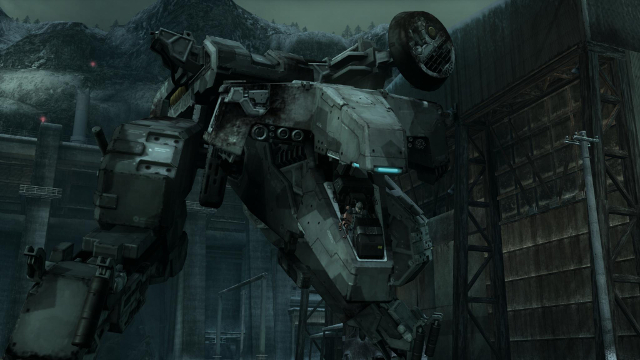
HE WHO CONTROLS THE BATTLEFIELD, CONTROLS HISTORY: Guns of The Patriots is set in a world where the economy of war is big business. The idea of a nation-less army, that Big Boss’s Militaires Sans Frontières had set in motion in Metal Gear Solid: Peace Walker, has been adopted and greatly expanded through the advent of Private Military Companies (PMCs) – personal armies for hire, who are never concerned with who or what cause or ideal they’re fighting for or against. The proliferation of nanomachines, as explored in Metal Gear Solid, has given rise to a battleground that is controlled and tactically dictated using technology – so much so, that even guns are ID locked, accessible only to those whose injected nanomachines match the same ID. All of these nanomachines are managed and maintained by a central system: Sons of the Patriots (SOP).
MGS4 excels in immediately immersing you in this war-focused world from the moment you start a new game. You’re instantly shown fictional television shows and adverts that you can flick through, ranging from commercials for PMCs and consumer weapons manufacturers, to a “survival cooking” show (inspired by Metal Gear Solid 3: Snake Eater’s survival gameplay), wherein the show’s resident chef invites a member of the audience to cut off a live snake’s head with a ceremonial sword before cooking. The chef explains that this is “the last chapter in this snake’s life!” – further giving the player enough of an impression that, no matter what the outcome is, Solid Snake’s time is coming to an end.
And when we meet Snake for the first time in this instalment, he has the appearance of an old man. Due to him being a clone, we find that he was genetically designed to only live a certain number of years, doomed to age prematurely and be unable to reproduce, to ensure his precious “perfect soldier genes” do not fall into the wrong hands.

Five of the largest PMCs in the world are owned by one parent corporation, named Outer Heaven. It’s CEO? Liquid Ocelot, the body of Revolver Ocelot and the mind of Liquid Snake – two of Solid Snake’s arch enemies in one being. It is discovered that Liquid is planning to seize control of the SOP system, and use this technology to control the entire world and to create the Outer Heaven ideal that Big Boss himself had set in motion, before it was torn down by Snake in Metal Gear 1. With this crisis looming, and with old Snake’s rapid aging in mind, it is clear that time is running out for our hero.
As for Snake’s “final” mission, his longtime Commanding Officer, Roy Campbell, sums it up pretty well in the first of the game’s lengthy Mission Briefings that begin each of the five Acts:
This isn’t justice. It’s a covert assignment – a hired hit…
…Snake, this mission isn’t an order from Washington… not like the old days. And it’s not something the U.N. can officially sanction, either…
…But we can’t just look the other way while Liquid plots this insurrection. If we fail to act, he’ll become the greatest threat the world has ever faced.
Taking place over five Acts, spanning areas around the world from the Middle East, to South America, to Eastern Europe, Guns of The Patriots violently tugs at the strings of nostalgia, while tying up all the loose ends of those strings. From the ridiculousness of Revolver Ocelot being possessed by the severed arm of Liquid Snake, to why recurring character Johnny “Akiba” Sasake is always having bowel problems. Practically all major and minor points are tied up in a way that would only make sense if you’ve been keeping up with the entire series all this time.
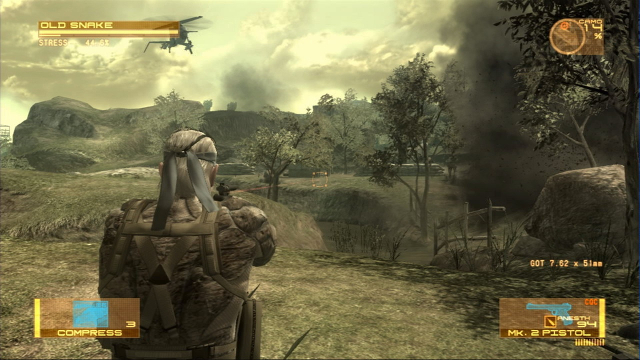
THE WORLD IS BORN… FROM ZERO: But that’s probably one of the Metal Gear series’ biggest stumbling blocks for new players. Each canonical entry is dripping in backstory, and Guns of The Patriots is no different, covering events in the Metal Gear timeline intertwined with real-life history. More than any other game in the series, you must be able to take every outrageous plot point as gospel, every exaggerated character as believable. However, once you surrender yourself to this world of nanomachines, bipedal tanks and possessed limb, it’s easy to be enthralled.
But given the series’ penchant for the weird and wonderful, this entry is far more grounded than previous instalments. The beautifully rendered locales are so hyper-detailed that they still hold up well today; the sandy streets of the Middle East are torn apart by the warring factions battling in front of your very eyes, the twilight noir atmosphere of the Eastern European town in Act 3 is a captivating stage for the stealth action contained within, while the South American setting in Act 2 is filled with wildlife – including cute guinea pigs that can be heard sqeaking in the surrounding grassy areas. These aren’t cold, sterile environments like the Shadow Moses and Big Shell environments of old – they are locales with character.
METAL… GEAR!? MGS4’s master-stroke is the entirety of Act 4, a chapter that takes you back to Shadow Moses, where the Solid series began. Beginning with an emulated playable version of the original game’s opening Helipad sequence, it is revealed to be a recollection from Old Snake’s dreams. From here, you’re returned to this iconic location. While it has been years since the facility was bombed, it’s only inhabitants are Liquid Ocelot’s army of unmanned Gecko mechs and their tiny, yet unnervingly odd Dwarf Gecko variations.
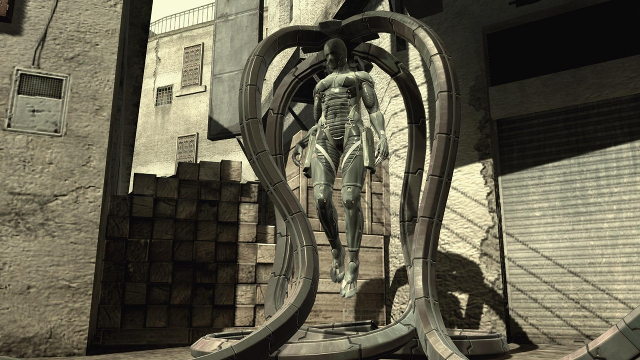
Seeing these now run-down corridors truly takes you back, with some of the walls still stained with the blood of Genome soldiers, massacred by Grey Fox/Frank Jaeger; others are complete with audio flashbacks of some of Metal Gear Solid’s pivotal moments. Then, you meet the burnt-out remains of Metal Gear REX, and get to pilot the infamous mech for yourself, culminating in a battle with one of Metal Gear Solid 2’s RAY models. It’s a titanic contest that wouldn’t be out of place in a Godzilla movie. It’s a megaton nostalgia punch to the face – pure fan service, and all the better for it.
WAR TRANSFORMS US, SNAKE – INTO BEASTS: While not quite in the same league as the rogues’ gallery in the original Metal Gear Solid, Guns of The Patriot’s Beauty and the Beast unit are certainly a memorable bunch of boss fights. This deadly unit are comprised of women (the Beauties) and their heavily armoured exoskeletons (the Beasts), each member sharing a similarity with each original MGS villain, as well as being driven by a specific emotion brought on by a traumatic experience in their lives.
An early encounter with Crying Octopus provides a particularly memorable encounter. Armed with Octocamo, enabling her to blend in with the surrounding environment, she hides in the small confines of a makeshift lab, laying in wait for Old Snake. You could cheat and track her down with your handy Night/Thermal vision goggles, but that takes the fun out of this battle of wits. She truly tries to outsmart you, disguising herself as paintings, a fallen soldier and even an anatomical model. It takes a bit of clever observation to track her down and get a few shots in.
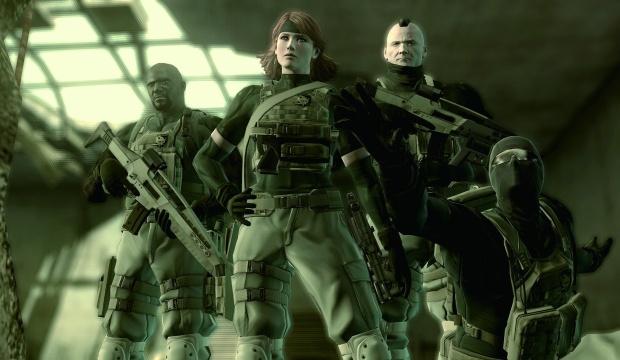
But this deadly unit aren’t your only concern – Metal Gear Solid 2’s allegedly immortal Vamp is also present while, of course, your mission culminates in a brutal battle with Liquid Ocelot himself. It’s a battle I couldn’t possibly spoil here, but it’s a truly climatic fight, and a fitting end to a series-spanning rivalry.
I AM LIGHTNING… THE RAIN TRANSFORMED: Something that is very apparent in Guns of The Patriots is the complete redemption of Raiden. Debuting in Metal Gear Solid 2: Sons of Liberty as a whiny rookie, never questioning his purpose in the events of The Big Shell Incident,; his role as the “bait and switch” protagonist in the game was a much derided one, and his ancestor’s appearance in Snake Eater very much seemed to be a response to this, as he was practically relegated to being antagonist Volgin’s whipping boy.
But the very first time you lay eyes on Raiden, it’s clear that this isn’t the same person you played as in the Big Shell facility. For a start, he’s been outfitted from head to toe in cybernetic implants, becoming a deadly cyborg ninja, not unlike Grey Fox in Metal Gear Solid. Taking on several Gecko mechs by himself, Raiden becomes a certified badass – a role the continues throughout Guns of The Patriots. Sadly, his appearance in Metal Gear Rising: Revengeance almost nullifies his coolness factor.
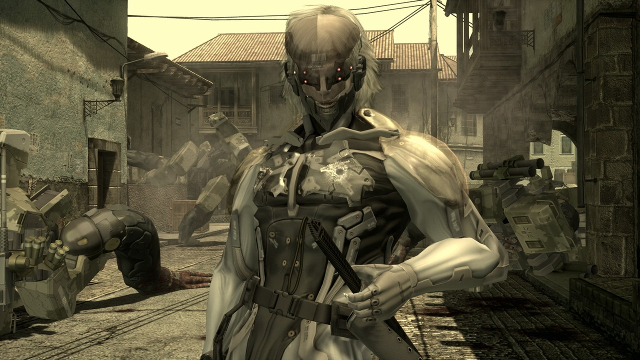
THIS IS GOOD… ISN’T IT?: What makes the game, for me, is the amount of depth and content there is here. I have spent over a month trying to see all there is to the game, finishing it at least eight times, earning all the completion Emblems (mini achievements that are received for finishing the game in a certain way).
No matter whether you want to play as stealthily as possible, or go out all guns blazing, for the majority of the game you can play it exactly how you want to. More-so than any other game in the series, a ton of collectable, unlockable and purchasable weapons/items are available (with many of them customisable with functional parts), allowing for a great deal of experimentation and general tomfoolery. Sure, you have your suppressed pistols, rocket launchers and assault rifles, but why not try the Tanegashima, a Japanese matchlock rifle from the 1500’s, that requires a painfully long reload time after each shot (and which, in a strange twist, has a small chance to cause a whirlwind that sweeps away any enemy in it’s path)? Or maybe you’d prefer the unlockable Solar Gun, taken from Hideo Kojima’s cult GBA game, Boktai – a non-lethal weapon with almost infinite ammo, provided you can find some sunlight to charge it.
There’s just so much scope for multiple playthroughs. While a full run, watching the game’s many cutscenes, can last upwards of 15 hours, subsequent playthroughs that keep all of your previous inventory items can easily be done in five hours or less (in fact, some Emblems require you to finish the game that quickly). Then, of course, you have the game’s ultimate challenge – earning the Big Boss Emblem for finishing the game on its hardest difficulty (The Boss Extreme), using no continues or health items, no kills, no alerts and no deaths. While not as difficult as in earlier Metal Gear games, it’s a worth test of your stealth skills, and one of the most satisfying gaming experiences you’ll ever have.
But the true greatness of Guns of The Patriots is that it’s the perfect way to close the book on Solid Snake’s story. While it’s not my favourite Metal Gear game (that honour goes to the underrated and underplayed Peace Walker), it’s an essential play, even for those who have not yet sampled the delights of the Metal Gear saga. With the full series being released in one box later this month as part of the Metal Gear Legacy Collection for PlayStation 3, you have no excuse to get involved with both this game, and the Metal Gear series as a whole.




